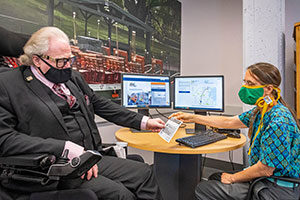
By Morgan Gaffney
The Massachusetts Commission for the Blind’s virtual town hall meeting on Friday marked a stride to further accessibility for those living with disabilities in the Boston area and beyond. The Massachusetts Commission for the Blind (MCB), in collaboration with Massachusetts Bay Transportation Authority (MBTA), discussed the services provided by MCB’s Orientation and Mobility Team, as well as MBTA’s Mobility Center, first opened in July 2022.
MCB’s Orientation and Mobility director, Ally Bull, described how the program helps the visually impaired learn to be able to navigate any environment safely and with confidence. Assistant general manager of the MBTA’s Department of System Wide Accessibility, Laura Brelsford, detailed the new Mobility Center as a “one-stop shop filled with resources regarding accessible transportation options.”
The two initiatives have been working closely together to improve the traveling conditions of those who are blind or vision impaired.
The Orientation and Mobility team is made up of specialists who help visually impaired individuals develop skills to adjust to their environments using non-visual and auditory tactics, cane techniques, technology training, and any other skills clients may need. Clients begin with a consultation to establish goals with their Certified Orientation and Mobility Specialist (COMS). They then undergo however many sessions to achieve the goals and skills they have set for themselves with their COMS. Lessons can take place at homes, prisons, colleges, nursing homes, or any place the Orientation and Mobility team’s services are needed.
The MBTA’s Mobility Center focuses on directly making public transit more accessible to those with disabilities and elderly folks. They take on roles such as providing training for frontline employees like station ambassadors, group training for riders and staff, closely monitoring and responding to any feedback given about accessibility, 1:1 Individualized Travel Training, trip planning assistance, help with reduced fare applications, among many other services.
“Previously it was the Eligibility Center, but now the MBTA has taken a more holistic approach in the way we provide services,” says Bianca Lightfoot, manager for Travel Training at the Mobility Center.
All services and trainings provided by the Mobility Center are free. 1:1 Travel Training, similar to MCB’s Orientation and Mobility Training, begins with a pre-training assessment to set goals for trainees. Trainers then work together with trainees to help acquaint them with different routes and stations, and how to navigate them with their disability.
Transit Access 101 is a one-hour class held at the MBTA Emergency Training Center covering the basics of the MBTA system, utilizing out-of-service Blue Line subway cars, Green Line trolleys, and buses for trainees to explore and familiarize themselves with. On-site group trainings run similarly, in which the class is held at the locations of interested organizations.
As for help with reduced fair applications, blind and visually impaired individuals are eligible for Bling Access Cards to use all MBTA. This card provides free travel to the individuals, as well as any sort of sighted guide accompanying them. Mobility Center staff help people apply with over the phone, online, or in-person assistance.
Casandra Xavier, an activist for deaf and blind communities who completed both MCB’s Orientation and Mobility Training and the MBTA’s Travel Training, was featured in a testimonial video during the meeting. She shared her experience on how these trainings have helped her be able to utilize public transit in the Boston area.
“I’ve been able to do all kinds of things with the MBTA, and I’ve learned new methods of getting around,” says Xavier.
The end of the meeting was dedicated to a question-and-answer portion, with a panel of several MCB and MBTA staff answering any community member’s questions.
There were questions regarding getting on and off transportation with a shopping cart, good navigation apps for the visually impaired, and how to find ambassadors in the stations.
One community member who has Cerebral vision impairment asked if Boston would ever implement the sunflower lanyard, a system used by many areas around the world to signify an invisible disability. She had a positive experience using it on the train system when she was in Sydney, Australia a few months prior.
“It’s a good way to notify the workers and ambassadors that ‘Hey, there’s someone with disabilities. We don’t know what, but they need help, and they might not want to be going up and asking.’ But if they look confused, they can come over,’” she says. “It would really help visually impaired people that are not ready for the white cane, but still need that help.”
Bull acknowledged the ingenuity of the idea. She added that the cane is a good signifier, whether the individual is visually impaired or not, to anyone who can help disabled people in these situations.













Reader Comments